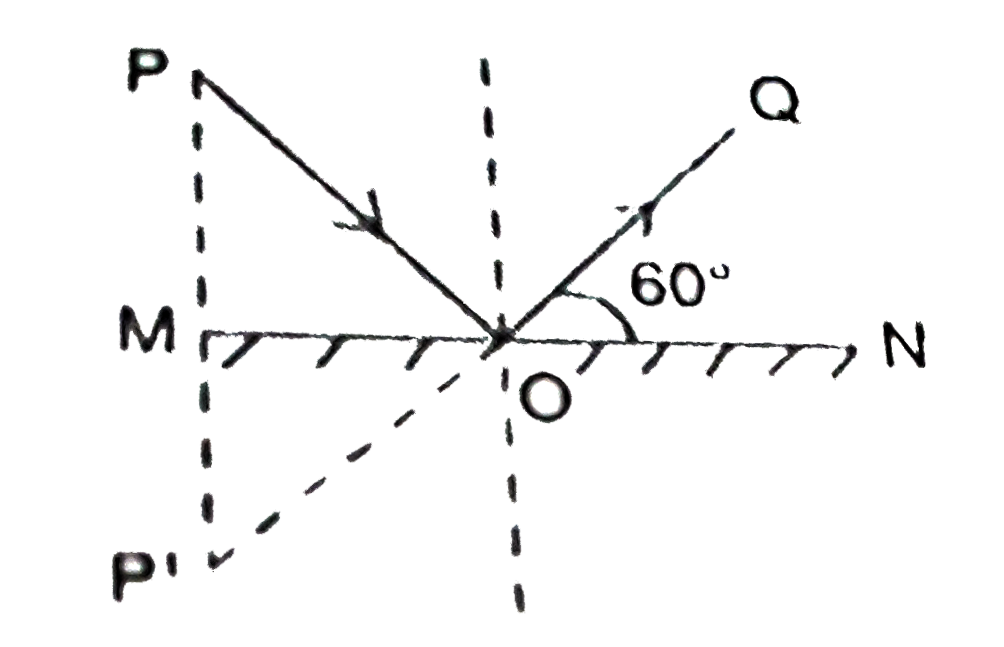The light rays from an object have been reflected towards an observer from a standard flat mirror, theimage observed by the observer are :-
A.Real
B.Freet
C.Smalten size then object
D.Laterally inverted
B and C only
A,C and D only
B and D only
A and D only
The correct Answer is:C
To solve the question regarding the properties of images formed by a flat mirror, we will analyze each option based on the characteristics of images formed by plane mirrors.
1. Understanding Image Formation by a Plane Mirror:
- A plane mirror forms images based on the laws of reflection. The image formed is virtual, meaning it cannot be projected on a screen, and is located behind the mirror.
2. Analyzing Each Option:
- Option A: Real - This is incorrect. The image formed by a flat mirror is virtual, not real.
- Option B: Erect - This is correct. The image formed by a plane mirror is always erect (upright).
- Option C: Smaller in size than the object - This is incorrect. The size of the image in a plane mirror is the same as that of the object.
- Option D: Laterally inverted - This is correct. The image formed by a plane mirror is laterally inverted, meaning it is flipped horizontally.
3. Conclusion:
- The correct properties of the image formed by a flat mirror are that it is erect (Option B) and laterally inverted (Option D). Therefore, the correct options are B and D.
Final Answer:
The correct options are B (Erect) and D (Laterally inverted).
- A plane mirror forms images based on the laws of reflection. The image formed is virtual, meaning it cannot be projected on a screen, and is located behind the mirror.
- Option A: Real - This is incorrect. The image formed by a flat mirror is virtual, not real.
- Option B: Erect - This is correct. The image formed by a plane mirror is always erect (upright).
- Option C: Smaller in size than the object - This is incorrect. The size of the image in a plane mirror is the same as that of the object.
- Option D: Laterally inverted - This is correct. The image formed by a plane mirror is laterally inverted, meaning it is flipped horizontally.
- The correct properties of the image formed by a flat mirror are that it is erect (Option B) and laterally inverted (Option D). Therefore, the correct options are B and D.
The correct options are B (Erect) and D (Laterally inverted).
Topper's Solved these Questions
Similar Questions
The image formed by a concave mirror is observed to be real, inverted and larger than the object. Where is the object placed?
View SolutionA ray of light travels from a light source S to an observer after reflection from a plane mirror. If the source rotates in the clockwise direction by 10∘, by what angle and is what direction must the mirror be rotated so that the light ray still strikes the observer?
 View Solution
View Solution
Knowledge Check
- Question 1 - Select One
The light rays from a point object placed at the focus of a concave mirror, after reflection
Aemerge perpendicular to the principal axis.Bemerge parallel to the principal axis.Cform real image.DBoth (b) and (c) - Question 2 - Select One
The light rays from a point object placed at the focus of a concave mirror, after reflection
Aemerge perpendicular to the principal axis.Bemerge parallel to the principal axis.Cform real image.DBoth (b) and (c) - Question 3 - Select One
The light rays from a point object placed at the focus of a concave mirror, after reflection
Aemerge perpendicular to the principal axis.Bemerge parallel to the principal axis.Cform real image.DBoth (b) and (c)
A light ray from an object 'P' is reflected from a mirror as shown in the figure, then
 View Solution
View SolutionA light ray from an object 'P' is reflected from a mirror as shown in the figure, then
 View Solution
View SolutionWhen an object lying in a denser medium is observed from rare medium, then real depth of object is
View SolutionWhen an object lying in a denser medium is observed from rare medium, then real depth of object is
View SolutionWhich of the following statements are true about image formation in a plane mirror?
A. The image is larger in size than the object.
B. The image is formed at the same distance as the object.
C. The image is laterally inverted.
D. The image is virtual.View Solution

